Description, Analysis, and Sources
A Report to Early American Industries Association
By Nancy S. Shedd
March 10, 1986
DESCRIPTION OF THE PROJECT: To investigate the building techniques, geographical distribution, and construction dates of log structures in Southeastern and Central Pennsylvania which employ vertical corner (and medial) posts rather than corner notches and to trace the historical antecedents of this method of construction.
An outline of the project work and aims, as contained in the grant application, called for (1) a canvass designed to identify examples of corner-post log construction, (2) photographs of examples, (3) historical documentation to date structures, (4) compilation and mapping of data collected, and (5) creation of an annotated bibliography. The plan of work was modified and the geographical focus was narrowed because the project was funded at $400.00, rather than the $1000.00 originally requested.
Restriction of the study area to Southeastern and Central Pennsylvania was necessary as a cost-cutting measure, as was the elimination of most travel expenses and, therefore, first-hand historical research. Despite these limitations, however, I think that the extent of the data collected by mail and phone, aided by photographs supplied by persons and agencies canvassed, was sufficient to allow valid conclusions to be drawn from it.
BACKGROUND OF THE PROJECT
DESCRIPTION OF THE HUNTINGDON COUNTY SAMPLE
The focus of this study is on a particular method of log construction which I first saw about 1972 in Penn Township, Huntingdon County, Pennsylvania, which was part of a larger area where hundreds of early buildings were being demolished by the Corps of Engineers during construction of Lake Raystown, on the Raystown Branch of the Juniata River. Eleven or twelve structures were identified which had vertical posts at their corners into which a full-length groove or individual mortises had been cut to receive the tenoned ends of the horizontal logs forming the walls.
Close examination of eight of these structures revealed variations in the technique beyond the two methods of fashioning the corner posts mentioned above. Some builders had been content, for example, with just four verticals, one at each corner of the building, but others had used medial posts in the front and back walls, or in the side walls, and sometimes in all four locations. Medials had some obvious advantages — allowing the builder to work with shorter, more manageable logs; preventing sag in longer horizontals; and permitting, if desired, the unlimited extension of a wall to lengths beyond the span of a single log. Interestingly, there was no particular correlation in this small group between the size of the building and whether it had medial posts; some small examples used medials, while some larger ones did not.
 One conventionally built log building, with interlocking corner notches, was found with a mortised medial post employed to extend the wall to a quite considerable length, showing that local builders could appreciate this virtue of the technique.
One conventionally built log building, with interlocking corner notches, was found with a mortised medial post employed to extend the wall to a quite considerable length, showing that local builders could appreciate this virtue of the technique.
Additional variety was noted in regard to whether the posts sat on a wooden sill or directly on the foundation and whether medials, where used, did double duty as door or window jambs. A minor variation was whether horizontals were held in their mortises or channels by one or two wooden pins.
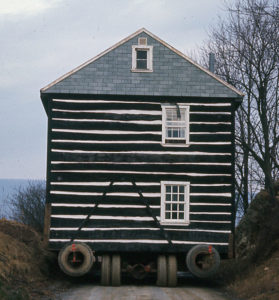 Just one example in this original group was seen with several haphazardly placed diagonals across its horizontal wall logs, which were vaguely reminiscent of the diagonal braces in post and beam construction or the diagonals seen in half-timbering. (House shown in photo while being moved to new location.)
Just one example in this original group was seen with several haphazardly placed diagonals across its horizontal wall logs, which were vaguely reminiscent of the diagonal braces in post and beam construction or the diagonals seen in half-timbering. (House shown in photo while being moved to new location.)
In this group of eleven corner-post log structures (the 12th was the building which combined medial posts with notched corners), nine were two-story dwellings; two (on the same property) were springhouses.
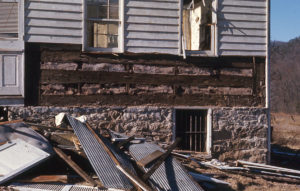 The dwellings varied in size from less than 20’ x 20’ to 40’ x 27’; five were completely sided, four were exposed. When removal of siding during salvage operations revealed the largest example to be corner-post log construction, it was evident that it had always been covered; the builder’s red chalk numbers, used to guide assembly of the pre-cut pieces, were still fresh and clear and the logs showed no signs of weathering.
The dwellings varied in size from less than 20’ x 20’ to 40’ x 27’; five were completely sided, four were exposed. When removal of siding during salvage operations revealed the largest example to be corner-post log construction, it was evident that it had always been covered; the builder’s red chalk numbers, used to guide assembly of the pre-cut pieces, were still fresh and clear and the logs showed no signs of weathering.
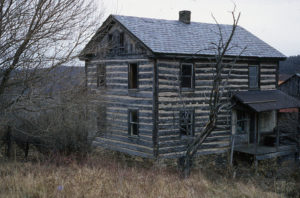
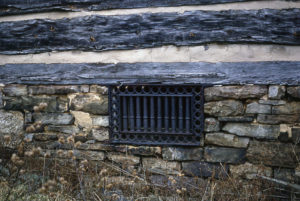 Several small examples had no cellars under them and appeared to be rather inexpensive solutions to the need for housing, but five had full basement stories of stone. One had a slate roof and cast iron grates over its basement windows like those more frequently seen in town houses, yet its logs were fully exposed — an odd combination of “citified” finishing touches with the primitive appearance of hewn logs.
Several small examples had no cellars under them and appeared to be rather inexpensive solutions to the need for housing, but five had full basement stories of stone. One had a slate roof and cast iron grates over its basement windows like those more frequently seen in town houses, yet its logs were fully exposed — an odd combination of “citified” finishing touches with the primitive appearance of hewn logs.
QUESTIONS RAISED BY THE SAMPLE
- Where did this unusual construction method originate — a method which I and other local amateur house observers with whom I discussed it had never seen? It was apparently far less common than the V-notching we saw typically.
- Why were they clustered in this small area? Was there, perhaps, a single builder who was responsible for introducing the technique and possibly even erecting all of these structures? The variations on the basic technique which have been noted, as well as what appeared to be different levels of craftsmanship in the execution, argued against a single builder but not necessarily against a single influence on others with varying skills and a few ideas of their own.
Preliminary deed and census research was inconclusive. My reading in Shurtleff’s The Log Cabin Myth and Weslager’s The Log Cabin in America did little to answer these questions. Articles by Brumbaugh and Kniffen and Glassie revealed at least that the technique was known elsewhere. Correspondence and conversation with Glassie and Brumbaugh confirmed that this method of building in log was considered rare, cause for concern since all eleven structures were scheduled for demolition. (In fact, one was moved and four were dismantled for salvage.)
ADDITIONS TO THE ORIGINAL SAMPLE GROUP
From 1977 to 1980, a thorough survey of historic structures was conducted in Huntingdon County as part of a state-wide program supported by the Pennsylvania Historical and Museum Commission. As director of the survey for the Huntingdon County Historical Society, I alerted those working with me to look for examples of corner-post log construction. Our efforts were rewarded by identification of 28 more structures entirely or partially constructed like those in the Raystown project area.
Only one house differed significantly from the original group: it was built of sawn posts and 5” thick planks instead of hewn logs, but the structural technique used was identical to the log versions. As in the majority of other examples, the wall timbers in this house were fitted into individual mortises, which made a question which had been bothering me and my husband (who had dismantled and re-erected one of the springhouses from the Raystown area) even more insistent: why had builders held the wall logs of these houses apart by the use of pins or the spacing of individual mortises instead of allowing them to slide down a continuous groove or channel and rest on each other? The case of the plank house, with its wall planks held about two inches apart, was even more puzzling since the planks, with their nicely squared edges, would have rested neatly on each other, forming a solid draft-proof wall.
The other new finds exhibited all the characteristics described in the original group and, except for the plank version, added no new variations. No more diagonals were seen, although many examples were sided and thus could not be examined in detail. Several examples were seen of vertical posts being used as the means of adding a three-sided addition to an existing log house; in those examples exposed to view, vertical posts used in this way were combined with interlocking notched corners in the original house and at the outer corners of the addition.
While the Huntingdon County survey was in progress, I contacted the directors of a handful of similar efforts then underway in the State, describing corner-post log construction and asking if they were seeing examples in their counties. From neighboring Centre County came word of two corner-post log houses, and from Bucks County description of a house apparently much like our one plank version of the type. Much later, the Monroe County director reported that she thought she had found an example, but I was unable in this most recent canvass to confirm that find.
ANSWERS AND QUESTIONS
With 28 additional examples of corner-post log construction in Huntingdon County and several in other locations, the answers to the questions stated under 2. above, were clear. This building technique was not confined to the Raystown area, and the possibility of a single builder or influence was out of the question.
The question of where the method of construction originated was broadened by knowledge of more buildings in more locations; if no maverick builder could be responsible, I was dealing with a traditional method of work. These were vernacular buildings, obviously the work of craftsmen who learned their trade the old-fashioned way — handed down from master to apprentice, from father to son, from generation to generation. Multiple practitioners, separated by both space and time, implied a long-standing, even if little known, tradition.
The aspect of time was particularly interesting and puzzling because research had shown a number of these Huntingdon County houses to have been built from 1855-1875. At the same time, research had not proved any Huntingdon County examples to have been built earlier than that period, although we suspected on the basis of certain internal evidence that the plank house dated before 1825. Yet the Golden Plough Tavern in York, which combined corner-post log construction in its first story with half-timbering in its second and third, was dated 1741; and a tiny story-and-a-half corner-post log house in Lebanon County (pictured in Brumbaugh’s “Colonial Architecture of the Pennsylvania Germans”) was said to date from the 18th century.
Thus it appeared that Huntingdon County’s corner-post log buildings had blossomed forth in considerable numbers very late in terms of log building generally and widely separated in time from known examples, which proved that the tradition was practiced in older sections of the State as much as a century earlier. Where had the tradition been kept alive before what looked like a brief renaissance had occurred locally?
Clearly, the answer to that question would not be found in Huntingdon County. More data from other counties was needed — data which did not seem likely to be available until more comprehensive surveys of historic buildings had been undertaken and completed across the State.
THE EAIA-SUPPORTED PROJECT
A CANVASS OF SOUTHEASTERN AND CENTRAL PENNSYLVANIA
Since the Huntingdon County historic sites survey was completed in 1980, the Pennsylvania Historical and Museum Commission, through its Bureau for Historic Preservation, has continued to fund such surveys across the State. With the assistance of Susan Zacher, the survey coordinator for BHP, I compiled a list of active survey directors and completed survey repositories to whom letters and questionnaires (see Appendices C 1 & 2 at end) were sent in June 1985 requesting their cooperation in collecting information on corner-post log structures. Additional contacts were made with historical societies and preservation groups, and with knowledgeable individuals whose names were suggested in responses to the initial mailing.
An inquiry and photograph also appeared in the Mailbox section of Pennsylvania Heritage, Fall 1985, and in the October newsletter of the North-central Pennsylvania Historical Association. My June letter to Historic York, Inc. brought a request that I speak on the history of log houses in general at a workshop the organization planned for November. This enabled me to describe my project briefly to about twenty-five York Countians with a special interest in log buildings. York County was potentially important to my study because the Golden Plough Tavern proved that the corner-post technique of log building was used in York as early as 1741. Yet this extensive effort to obtain information on additional corner-post log structures in York County has brought reports of only two: one from a board member at Historic York before I spoke there in November 1985, and one in February from a member of the workshop audience. (Further comments on what this lack of sightings in York County, where more examples would seem likely, means will appear later in this section of the report.)
A summary of contacts and responses, arranged by county, has been compiled as part of this report to give an overall impression of the extent of the canvass and its success with regard to the number of respondents and the number of relevant buildings reported. (See Appendix A at end.) These numbers are still changing; I revised the table three times in the past month as additional reports have been received, even in one case from a county (Indiana) where I had been assured there were hardly any log buildings of any kind.
The table does not include contacts with scholars in the field: particularly Donald A. Hutslar of the Ohio Historical Society; Dr. Bernard Herman of the Center for Historic Architecture and Engineering, University of Delaware; and Dr. Wilbur Zelinsky, Department of Geography, Pennsylvania State University. They helped, along with published books and articles, to place the partial Pennsylvania sample with which was working in a larger context.
Nor does the table in all cases include or accurately represent persons who provided information on a county other than their own or on several different counties. In Huntingdon County, I listed only myself as contact and respondent although, in fact, dozens of countians contributed to my knowledge of corner-post log structures. That fact is clear in the section of this report which recounts the background of the present project.
Nevertheless, the table is valuable as a reporting device, condensing a quantity of information into a form which can be quickly grasped and allowing discussion to focus on significant aspects selected from the overall picture.
ANALYSIS OF THE NEW DATA
A quick glance at the summary of contacts and responses shows that Berks and Cumberland Counties have a much higher number of corner-post log structures than elsewhere in the 30-county area canvasses, except, of course, for Huntingdon, which has the most by a wide margin. But the quick glance is misleading, for that is not what the table shows at all. The table records the number of buildings reported, which is not at all the same as the real number of such buildings in those and other counties.
Two facts explain Berks’ and Cumberland’s high numbers: the buildings are there, and the surveys in progress in those counties are paying close attention to vernacular structures. Where either of those conditions is lacking, the results will be very different. Obviously, my ability to draw accurate conclusions, based on the data received as a result of this canvass, depends on the accuracy of the information reported. And since I have good reasons to question whether the number of buildings reported accurately reflects the number of corner-post buildings existing in many areas (or all those which ever existed, which is an even more vexed question), the conclusions which I have based on this data are more impressionistic than statistical, the neat columns and figures of the table notwithstanding.
In my reading on log buildings, I have seen enough conclusions based on inadequate data or naively analysed data to think that this preamble to the analysis of my data could profitably include closer attention to the reasons why I doubt my numbers.
First, let me explain why the Huntingdon County numbers are so high: (1) in terms of the time spent and the number of people involved, our survey of an entire rural county was incredibly thorough. We talked with owners at every opportunity, and made a particular effort to learn the construction concealed beneath all kinds of siding. (2) We attempted to find every site on our 1873 base maps, walking to many not accessible by car. (3) Because the county has not been heavily developed, many old structures have been allowed to stand even if derelict or used just as hunting camps. Many poor, old houses are still occupied, and their poor condition often allowed us to see their “innards.” (4) The demolition for Lake Raystown drew attention to this unusual method of construction and uncovered five examples which would otherwise have escaped detection. (5) The late construction dates for many examples may have contributed to their being in good enough condition to survive and to remain usable. (6) it may even be that the method was unusually popular here or unusually popular at a late date. Huntingdon County has a great number of conventionally notched log houses as well.
Why aren’t Berks’ and Cumberland’s numbers as high? (1) Their surveys are still in progress. (2) I think Cumberland has both less time and fewer people involved, so may not be able to linger as long on each property. (3) Both counties have at least some areas which have been much more heavily developed, which usually means the loss of early structures.
Why aren’t there more reports from counties like Bucks, Chester, Lancaster, and York, areas with rich architectural and cultural traditions which strongly influenced Berks, Cumberland, and Huntingdon Counties? There are many answers to this question, including significant differences in their status with regard to surveys. Bucks and York have done only partial surveys, York’s being particularly lacking to this date in information on rural areas. Chester’s and Lancaster’s surveys are complete, but because of the richness of their architectural resources, their surveys tended to concentrate on high style buildings, rather than on vernacular structures whose value is harder to gauge. Three of the buildings included in the Chester total in the table appear in a book on Chester County architecture. Several attempts to learn whether the buildings pictured still exist yielded no information from any of the sources contacted. Yet that would seem to be a simple question to answer in a county where a recent survey has been done. Clearly, it has been focused in a different direction.
Information on corner-post log houses in Lancaster County has been equally difficult to obtain. Persons active in their survey reported an example in Lititz which I later dug out of the files at Harrisburg. A second example, no longer extant, I spotted in a photo exhibit at the Lancaster Heritage Center. It was particularly important because of combined log and half-timber construction like the Golden Plough at York. The others in the Lancaster total came by chance from a York County contact and from a late and important contact made through the Lancaster Mennonite Historical Society.
My point is that reliable reports have been very difficult to obtain in potentially rich, early, and significant sections of the canvass area.
In all areas, it is a fact of life that most log structures are sided and, therefore, keep their own secrets. Even if it can be determined that they are log (many home owners have seen inside some portion of their walls when plumbing, wiring, or remodeling), the method by which these logs were assembled is not usually known.
One last question reflecting on the reliability of data: What does it mean that in the seven counties surrounding Huntingdon, where 40 buildings were found with corner-post construction, reports indicate a total of just seven corner-post log buildings? It might mean that Huntingdon County’s traditions are radically different in some respects from its neighbors’. I doubt that seriously; in this case, five of the seven counties have not conducted historic sites surveys. Three did not respond at all to my letter. Yet the two adjoining counties which have made complete surveys report only three examples.
Adjoining counties do not have to be alike. For example, my distinct impression, without having counted, is that the majority of Centre County barns are very different from Huntingdon County barns, and in another adjoining county —Franklin — there is a rash of renowned brick barns, while Huntingdon has just one. Nevertheless, I do not trust the reported data to be nearly as significant as it would seem in terms of numbers alone.
I do find it significant that more than 100 corner-post log buildings are known, scattered over 20 of the 30 counties canvassed. Certainly the technique was much more widely known than has been thought, and its origin and transmission, as a tradition quite distinct from notched log construction, clearly deserves more careful study.
KEY EXAMPLES OF CORNER-POST LOG BUILDINGS
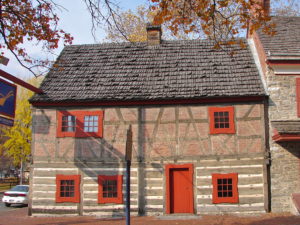 Golden Plough Tavern, York, York County, c. 1741: Important for it early date of construction for or by a German owner, Martin Eichelberger, and its combination of corner-post log and half-timber building traditions. It displays other Germanic architectural elements as well in what is thought to be a careful and accurate restoration by G. Edwin Brumbaugh. Its wall logs are pinned into continuous channels in the vertical posts, and the resulting spaces between the logs are filled with stones and mortar. No diagonals were used in the log first story.
Golden Plough Tavern, York, York County, c. 1741: Important for it early date of construction for or by a German owner, Martin Eichelberger, and its combination of corner-post log and half-timber building traditions. It displays other Germanic architectural elements as well in what is thought to be a careful and accurate restoration by G. Edwin Brumbaugh. Its wall logs are pinned into continuous channels in the vertical posts, and the resulting spaces between the logs are filled with stones and mortar. No diagonals were used in the log first story.
A photograph at the Lancaster Heritage Center shows a quite similar building being demolished in downtown Lancaster many years ago.
Hess Homestead, Lititz, Lancaster County, c. 1744: This house is being restored by a descendant of the Hess family. The builder was a Swiss Mennonite, born in Canton Zurich. The house was originally 1½ stories; the horizontals are fitted into individual mortises in the posts. It has six posts across the front, four doing double duty as door and window jambs. There are diagonal braces let into the horizontals on the interior near the corners, from the sill to the header, but not let into the corner posts, as most diagonals have been.
Upper and Lower Swedish Cabins, Delaware County, 17th Century: These buildings have immense importance because of the assertion by Mercer, Shurtleff, and others that the Swedes introduced log construction into America about 1638. Leaving aside the controversy (for their contention has been challenged), it is important in the context of this study to note that both cabins have apparently three-sided additions attached by vertical posts or planks. Bealer’s photos are helpful, but also puzzling in certain respects, as are others I have seen. I hope to examine these buildings in person.
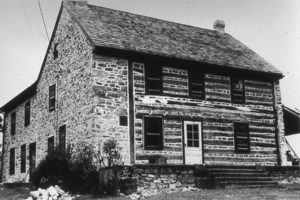 Whelen House, Route 401, Chester County, 18th Century: This house has a 5 or 6 foot deep stone end with huge fireplace and chimney against which 2-story high vertical channeled posts are placed to hold the tenoned logs of the front and back walls. The other end of the logs are notched and joined to alternating courses of logs which are tied into a thinner stone end. The fill between the logs is stone and mortar, and the log walls were stuccoed or plastered, inside and out. This house is important for combining two methods of log construction with stone in a most unusual way and because it shows evidence of two corner fireplaces, often identified as being Swedish.
Whelen House, Route 401, Chester County, 18th Century: This house has a 5 or 6 foot deep stone end with huge fireplace and chimney against which 2-story high vertical channeled posts are placed to hold the tenoned logs of the front and back walls. The other end of the logs are notched and joined to alternating courses of logs which are tied into a thinner stone end. The fill between the logs is stone and mortar, and the log walls were stuccoed or plastered, inside and out. This house is important for combining two methods of log construction with stone in a most unusual way and because it shows evidence of two corner fireplaces, often identified as being Swedish.
Photos of this house enabled me to recognize Fig. 17 in Mercer’s Origin of Log Houses, a house in Chalfont, Bucks County, which was demolished about 1910, as being identically constructed except for having just one stone end.
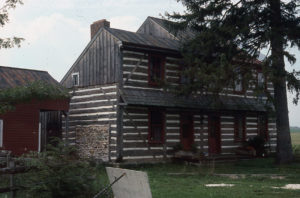 Heim House, Route 45, Union County, date unknown: This exciting house was recently uncovered. It is a classic example of vertical post log construction, with five posts across its front and diagonals bracing all its corners. I plan further research into the origins of this house.
Heim House, Route 45, Union County, date unknown: This exciting house was recently uncovered. It is a classic example of vertical post log construction, with five posts across its front and diagonals bracing all its corners. I plan further research into the origins of this house.
Ober Houses, Bedford and Indiana Counties, 19th century: Information arrived just last week, via the BHP office in Harrisburg, on a corner-post log house in Indiana County which was built by John Ober before 1844. He had come to Indiana County from Bedford County. The house is still owned by descendants of John Ober’s daughter, Nancy, and her husband, George Diehl. For some reason, I remembered that a title search on a corner-post house which was moved and reconstructed at Old Bedford Village included the name Ober. In fact, the Bedford County property on which the house originally stood belonged to Obers between 1828 and 1869. I hope further research in Bedford may reveal clues to dating the Old Bedford Village house and establishing the Ober family connections. Clarke Hess, owner of the Hess Homestead (above) and a director of the Lancaster Mennonite Historical Society, is checking on Lancaster County Obers who he believes are connected with those who went to Bedford County.
If knowledge and use of this method of log construction was traditionally derived and transmitted, connections of the kind that seem to be developing with the Ober family should exist, and with luck a few should be possible to uncover.
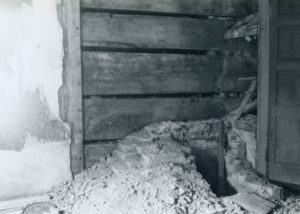 Neff House, Logan Township, Huntingdon County, before 1825: This plank version of corner-post log construction is important for demonstrating that this variation, otherwise reported only in Bucks and Chester Counties, was also known by at least one builder more than half way across Pennsylvania. I do not mean to suggest a direct connection; perhaps it is more important to demonstrate that isolated examples of European traditions may appear in this country without in the long run re-establishing the vitality and usefulness of the Old World technique. Plank versions of the method, which apparently have a long history in Europe, may have been less influential here than log because they appear to have been concealed immediately with siding.
Neff House, Logan Township, Huntingdon County, before 1825: This plank version of corner-post log construction is important for demonstrating that this variation, otherwise reported only in Bucks and Chester Counties, was also known by at least one builder more than half way across Pennsylvania. I do not mean to suggest a direct connection; perhaps it is more important to demonstrate that isolated examples of European traditions may appear in this country without in the long run re-establishing the vitality and usefulness of the Old World technique. Plank versions of the method, which apparently have a long history in Europe, may have been less influential here than log because they appear to have been concealed immediately with siding.
It is important to note that the structural system which gets a building up in the air and gives it strength and stability is identical whether built in plank or log. The variations such as full-length channels versus individual mortises, wall timbers pinned apart versus resting on each other, are ultimately unimportant; and the realization that these variations are incidental leads to recognition that the structural system is really post-and-beam (as is half-timbering). As a student of corner-post log construction, I have found these plank houses particularly useful in stimulating me to think about what is essential to the method and what is variable.
Spahn and Stober Houses, Clay and Walker Townships, Huntingdon County, c. 1870: Philip Spahn and Godfrey Stuber (as the 1870 census taker spelled his name) were recent German immigrants who built corner-post log houses in Huntingdon County at a very late date. The houses are located quite a distance from each other and are very different in plan; in other words, I do not suggest there is any connection between them. Their importance lies in what looks like direct importation of the technique from Germany, or at least choice of the technique by directions to a builder or by hiring one familiar with the method. Spahn was born in Nassau, Germany, and apparently continued to live there, for his three children were all born in Nassau. Stober was born in Wertemberg. Both places are in southwestern Germany.
I am told that the one Fulton County example of corner-post log construction reported to me was built by a new German immigrant. I am certain this is not the explanation for many Huntingdon County corner-post log houses, but there seems to be a distinct possibility that a long-standing minor tradition is crossing with new importations of the technique directly from Europe. There are, however, a number of other late Huntingdon County corner-post log houses which appear to have no recent German connection.
CONCLUSIONS
Evidence collected during the course of this project proves conclusively that corner-post log construction was known and practiced over a larger geographical area and a longer period of time than has been previously recognized. Twenty of thirty counties canvassed in Central and Southeastern Pennsylvania report at least one example; it is fairly safe to speculate that where one or two are known presently, more examples are hidden under siding or have been destroyed at some time in the past.
Written sources included in the Selected Bibliography show that European antecedents for the method are widespread and very old. This knowledge helps to explain the existence of very similar traditions in Canada, New England, Ohio, and the Mississippi Valley; clearly, the method of construction was transmitted from various places of origin to different regions of North America separately. Men familiar with New England forts or garrison houses built Campus Martius at Marietta, Ohio, and French explorers influenced buildings in both Canada and the Mississippi Valley, but the origins of the traditions conveyed to Pennsylvania can be sought without regard to the specific sources of influence in these separate cultural regions.
Emerging evidence suggests a strong German and Swiss strain in the building traditions as seen in Pennsylvania, brought in by immigrants over a period of at least 130 years. The history of political and religious upheaval and the consequent movement of persecuted groups and individuals in 17th and 18th century Central Europe argues for the likelihood of cross-fertilization of European building traditions prior to periods of immigration to the United States, particularly in the important area where Germany, France, and Switzerland join.
Rempel’s suggestion that the French antecedents of Canadian corner-post log buildings were lighter-built (plank, perhaps, or more delicate timbers than would be called logs) and that the more severe climate in Canada and the abundance of wood made the use of heavier logs a natural adaptation of traditional practice may certainly be true. But Phleps does show European buildings of corner-post construction in log as well as plank. It is hard to overestimate the importance of the illustrations in Phleps’ Alemannische Holzbaukunst in demonstrating, to my satisfaction at least, that the regions from which so many of Pennsylvania’s German and Swiss immigrants had come did indeed produce buildings in which could be seen the same characteristics found in corner-post buildings of Pennsylvania.
I must acknowledge the spur to my research which was provided by two lengthy telephone conversations last November. The first was from Donald Hutslar who suggested a possible Mennonite connection with corner-post log construction because of houses he had found in a Mennonite section of Western Ohio. That suggestion was followed closely by a call from Bernard Herman, who described slightly different but related houses he knew in Delaware. His feeling was that they represented an invented technology, and he advised forgetting the Mennonites.
These two conflicting pieces of advice prompted me to investigate the Mennonite connection in order to decide whether to drop it. As a result, I renewed efforts to find a Lancaster County source of information, and through the Lancaster Mennonite Historical Society was fortunate in finding Clarke Hess and his important Swiss Mennonite house. Further reading in Mennonite history revealed that the Neff family, builders of the Huntingdon County plank version of corner-post construction, had probably immigrated to Lancaster County with the same Mennonite group as the Hess family.
The Raystown area of Huntingdon County, specifically Woodcock Valley where I first recognized corner-post log houses as unusual, was more heavily German than many other sections of the county. It had the only Mennonite congregation in the county, as well as one of two early German Baptist Brethren or Dunkard congregations. Among the original owners of corner-post buildings there were Grubbs, Beavers, Snares, and Brumbaughs — all of German origin.
The evidence of a German, rather than specifically Mennonite, connection continues to mount with the 1870 Spahn and Stober houses, built by recent German immigrants, and the Ober house in Indiana County with its probable connection to the only reported Bedford County corner-post log house. My Snyder County respondent, a contractor and house mover, who reports knowing many such houses, lives in a section with a heavy German population, and York’s population had a large German component when the Golden Plough was built. Although little is known about Martin Eichelberger, who built the tavern or had it built for him, there is no question he was German.
This report should not end without some consideration of the structural system which corner-post construction represents and the problem of giving it a name which distinguishes it from more common log construction in which timbers are laid up in alternating tiers. The discussion might be headed “When is a log house not a log house?” and “The French had a name for it.”
Hermann Phleps’ Allemannishe Holzbaukunst offers undeniable proof that the corner-post log or plank method of construction had old, widespread European roots, extending even to Scandinavia. Many of Phleps’ illustrations show plank-dimensioned wall timbers with full-width tenons which are slid down the channels of posts until they rest upon each other. The corner-post buildings seen in Pennsylvania often involve modifications of one or another of the materials or the manner of Phleps’ examples, but the modifications are never ones which change the basic structural system on which the buildings depend for their erection. The fact that the structural system is essentially the same as post-and-beam or half-timber framing is basic to understanding their place in the evolution of construction methods.
The horizontal logs which form the walls of a corner-post building are really (along with their mortared stripes) just filler. Replace them with brick or wattle and daub and you have a half-timbered building. Knowing that, can we continue to call them log houses, thus throwing them into the same bin as alternating-tier log buildings to which they are really unrelated?
Here is where the French had it all over the English (or the Canadians over the Americans): they had two distinct labels for the two distinct systems of building in log — pièce sur pièce for logs lying on each other in alternating tiers, and poteaux sur soles for posts on sills or corner-post construction. There may have been some confusing of the terms, perhaps among the English Canadians who Rempel shows to have adopted and frightfully misspelled the French terms for the parts of a building; but properly used, they had the very real virtue of recognizing the basic characteristics of each structural system and allowing non-essentials like types of corner notches or shape and dimensions of timbers to vary without necessitating a different name.
But serious confusion arose, with respect to terminology which can be used without fear of misunderstanding among present-day students of log buildings, when Kniffen and Glassie, in an article which absolutely everyone relies on as gospel, not only got the French terms backwards, but castigated publicly those who had them straight. T. Ritchie’s article, which tries to set matters right, really concerns another subject and comments only peripherally on the confused terminology. The problem may be that one vaguely understood French term seems as good as another; I recently saw corner-post log construction referred to as poteaux en terre, which refers to palisade construction.
Another unfortunate aspect of the use of French terminology, even if correctly applied, is that it seems to promote the idea that the method is French. Part of the problem may be that Canadian investigations of their tradition have, of course, found or postulated French antecedents. Americans have repeated these conclusions even when the idea did not make sense as a source of Pennsylvania examples. Actually, Phleps’ work would suggest the technique is not only French, but also German (and more). Thus if, as in Pennsylvania, there are 95 German immigrants to every 5 French (or whatever the actual figures may be), there is no reason to quote the Canadians and call the technique French.\
Another bar to clear understanding of what is represented in these corner-post log houses is the typical list or diagram which describes types or varieties of “cornering” or “corner-timbering.” Usually there are 5 or 6 varieties, including the dovetail, the half dovetail, the V-notch, and the mortise and tenon joint. Such presentations convey the impression that the difference between the dovetail and the V-notch is the same as that between the dovetail and the mortise and tenon. Almost no mention is made of the entirely different structural system involved.
I have no expectation of being able to revolutionize ways of thinking and talking about corner-post log construction, but I am grateful that EAIA support of this study has allowed me to assemble new and significant information on a little-known and poorly understood Pennsylvania building type.
[See “Corner-Post Log Buildings Found Since 1986,” following the Bibliography.]
ANNOTATED BIBLIOGRAPHY OF SOURCES IMPORTANT TO THE STUDY OF CORNER-POST LOG CONSTRUCTION
Bealer, Alex W. The Log Cabin: Homes of the North American Wilderness. Barre, MA: Barre Publishing, 1978. Biblio. Index.
Beautiful color photos abound in this book, but note that virtually all the buildings are restorations and reproductions of varying authenticity. The title is much broader than the photo coverage, which is heavily Southern, suggesting a regional familiarity and bias which colors the text as well. In effect, generalizations based on Southern practice do not apply equally well to Pennsylvania and probably to other distinctive regions. Bealer’s treatment of corner-post log construction (pp. 45-46) describes a quirky French variant, but implies it is a typical example. The description is difficult to follow and useless, anyway, to understanding Pennsylvania examples. But Bealer’s attempt at describing the addition to the Upper and Lower Swedish cabins, in Delaware County, and the photos (pp. 147-150) of these possible prototypes of early Pennsylvania log building are valuable in reminding that there is a chance early Swedish practice influenced early southeastern Pennsylvania building.
Brumbaugh, G. Edwin. “Colonial Architecture of the Pennsylvania Germans,” Pennsylvania German Society, Vol. 41. [Delivered as an address Oct. 23, 1931.]
Brumbaugh devotes very little space to corner-post log construction, but contributes importantly to the over-all study in several ways: (1) he describes accurately (pp. 25-26) several significant variations on the technique, calling them types 4 and 5 under his discussion of six types of German log construction (although type 4 is sawn); (2) he includes, as plates 10 and 11, two photos of an early Lebanon County example of corner-post log construction; and (3) he points out in this early work (early in terms of serious studies of vernacular housing) the relationship between corner-post log construction and half timbering.
Brumbaugh played a later role in expanding our knowledge of this kind of construction when he served as architect of the restoration of the Golden Plough Tavern in York, Pennsylvania’s premier example of early corner-post log construction combined with half timbering (just in case we doubted that the same people were comfortable with both techniques). He called the method “poiteau cannale” or channeled post. [I think the proper spelling should be “poteau cannelé.”]
Erixon, Sigurd. “The North-European Technique of Corner Timbering,” Folkliv, No. 1 (1937), pp. 13-63.
Erixon maps and illustrates “section plank wall” construction (“skiftesverk”) in Scandinavia, locating it principally in the southern half of the peninsula, where it overlaps with areas of concentrated half-timber construction (“korsvirke”). He finds skiftsverk used mainly for barns on poorly wooded plains, but also for dwellings in more southern regions, combined with “very old-fashioned” construction details. On the continent, he notes the section plank wall technique is “especially characteristic of the wide belts where the half-timber shell in Western Europe meets the corner timbering of North and East Europe.”
Hale, Richard W., Jr. “The French Side of the ‘Log Cabin Myth,’” Proceedings of the Massachusetts Historical Society, Vol. 72 (1957-1960), pp. 118-125.
Hale describes and documents the French tradition of log construction in North America, including grooved post with horizontal tenoned wall logs (which he terms “poteaux sur soles”) as well as interlocking notched corners (which he terms “pièce sur pièce”). Hale’s aim is to support Harold Shurtleff’s contention (in The Log Cabin Myth) that log building methods are not “American” but have European origins; but Hale is concerned to add the necessary French component to Shurtleff’s discussion of the importance of the Swedes on the Delaware.
Hutslar, Donald A. The Log Architecture of Ohio. Columbus: The Ohio Historical Society, 1972, 1977. Biblio.
Important in the context of this study for the description (pp. 6-9) of Campus Martius (a fortified settlement erected in 1788 by New England settlers at Marietta) which employed 4-inch thick plank walls mortised and pinned into vertical posts. Hutslar also diagrams corner-post construction among types of log cornering (pp. 70-71). See photos, pp. 74, 88.
Hutslar, Donald A. “Symbolism, Nostalgia, and Reality: Log Construction in 19th Century Ohio,” Timeline, June-July 1985, pp. 26-53.
Includes photo (p. 42) of a partially unsided story-and-a-half corner-post log house which Hutslar says is similar to ones “found among the Amish and Mennonite settlements in Ohio, suggesting an origin in the Alpine region of present Germany, Austria, and Switzerland.” He repeated this suggestion to me in a telephone conversation, leading to an important part of the investigation and conclusions contained in this report.
Jordan, Terry G. American Log Buildings: An Old World Heritage. Chapel Hill: University of North Carolina, 1985. Biblio. Index.
Jordan has made the most thorough investigation of European log buildings ever undertaken by an American, but the limitations he imposed on which areas of Germany he studied resulted in exclusion of certain areas of important German immigration to Pennsylvania. German scholar Hermann Phleps’s books on log and timber building point to the existence of antecedents which Jordan did not find. This is unfortunate because Jordan’s book appears to be so complete that scholars will depend heavily upon its findings.
Speaking as a Pennsylvanian, I question whether Jordan, a Texan, is as familiar with the Southeastern Pennsylvania “hearth” area of his “Midland culture region” as he might be, and particularly whether he is sufficiently acquainted with the great diversity of influences which are manifest in Pennsylvania just beyond that “hearth.” I find Pennsylvania a great deal more complicated than Jordan’s book implies; the lines of influence he follows are simply too narrowly defined. In particular, his neglect of Palatine Germans, including those whom religious persecution in France, Switzerland, and elsewhere drove into the Palatinate for varying periods of time, seriously undermines the value of his book.
The examples he did find which relate to this method of construction are indexed under “corner posting.”
Kniffen, Fred, and Henry Glassie, “Building in Wood in the Eastern United States,” Geographical Review, LVI (Jan. 1966), pp. 40-66.
Everyone regards this seminal article as authoritative with respect to methods of log construction. Unfortunately for students of corner-post log construction, the authors take exception to the French terminology used by Canadian authors Richard Hale and Marius Barbeau to describe corner-post and interlocking log construction, calling their terms modern perversions of traditional usage. But a later article by T. Ritchie of the National Research Council of Canada, Division of Building Research, supplies early French sources which confirm the Canadians’ usage. All this leaves otherwise useful French terminology seriously confused.
Long, Amos, Jr. The Pennsylvania German Family Farm. Pennsylvania German Society, Vol. VI, 1972.
Long simply mentions early Pennsylvania German farm houses of sawn corner-post construction (p. 80) and suggests the relationship to half-timbering. He also describes log barns having vertical corner posts (p. 327), thus confirming use of the technique among the Pennsylvania Germans without commenting on the extent of that use.
Mercer, Henry. The Origin of Log Houses in the United States. Doylestown: The Bucks County Historical Society, 1967. [Presented as an address January 19, 1924.]
Mercer does not discuss varieties of log construction per se, but he includes photos of two important early buildings which employ verticals into which the horizontal wall logs have been mortised and pinned: Fort Halifax, Winslow, Maine (Fig. 5 and 6) and a stone and log house at Chalfont, Bucks County (Fig. 17) which combines vertical posts next to its stone end with interlocking notches at the far corners. I would not have recognized this unusual construction for what it was (the house was demolished in 1910) had I not been sent recent photos of an identically constructed house in Chester County.
Phleps, Hermann. Alemannische Holzbaukunst. Weisbaden: Franz Steiner, 1967.
Phleps, Hermann. The Craft of Log Building. Ottawa: Lee Valley Tools Ltd., 1982. Index.
These two immensely detailed studies of European wooden building techniques offer ample evidence that there are ancient and continuing antecedents for the American buildings which are the subject of this study. Initially I was puzzled by not finding the corner-post log technique in the new English translation of Phleps’ book on log buildings; he showed the technique only as a means of framing doors and windows in log buildings. Eventually I realized Phleps might classify corner-post log construction as a timber framing method and so would include it in his untranslated and less widely available work on that subject.
That was, indeed, the case. The German text was largely beyond my comprehension and difficult for the German speakers I consulted because of the specialized vocabulary Phleps used, but the photos and other illustrations, with their brief captions, were clearly related to the buildings I was studying. Phleps’ map showing the spread of “Alemannische” influence by the fifth century makes it clear beyond a doubt that the European roots of the technique are very old. He includes illustrations from ancient source materials and photos and drawings of surviving examples from a wide geographical area, from Scandinavia to Switzerland and France to Bavaria, much of it the area neglected by Jordan.
Rempel, John I. Building with Wood and other aspects of nineteenth-century building in Central Canada. Toronto: University of Toronto. Rev. Ed., 1980. Biblio. Index.
Explores the French antecedents of Canadian “grooved post” or “post and fill” construction, both of which Rempel (like Phleps) classes with timber framing rather than log construction. Despite my belief that the Pennsylvania buildings with which I am concerned do not have French antecedents (unless one traces all European traditions to a single very remote source), I find Rempel’s book both interesting and useful, particularly pp. 14-24 and 140-151 in which he deals specifically with structures like those which interest me. Rempel sides with his compatriots, by the way, in his identification of common interlocking log construction as pièce sur pièce.
Ritchie, T. “Plankwall Framing, a Modern Wall Construction with an Ancient History,” Journal of the Society of Architectural Historians, Vol. XXX, No. 1 (March 1971), pp. 66-70.
Before going on to discuss examples of thoroughly modern plankwall construction in Montreal apartment buildings, Ritchie wades into the murky waters of proper French terminology for the traditional methods to which the modern practice is related. He quotes 17th and 18th century sources which confirm Hale and Barbeau’s usage to which Kniffen and Glassie objected, and he offers additional terms from old sources, including poutraux encanelles, which is also misspelled but is obviously related to the term applied by Brumbaugh to the Golden Plough Tavern.
CORNER-POST LOG BUILDINGS FOUND SINCE 1986
Not surprisingly, additional corner-post log buildings have been discovered since this report was written in 1986. Here is a sampling.
 A rather crude, cheaply-built example was uncovered at the corner of 4th & Mifflin Streets in Huntingdon Borough when a building was being demolished to make a small parking lot. Its corner-post log construction had been concealed by siding.
A rather crude, cheaply-built example was uncovered at the corner of 4th & Mifflin Streets in Huntingdon Borough when a building was being demolished to make a small parking lot. Its corner-post log construction had been concealed by siding.
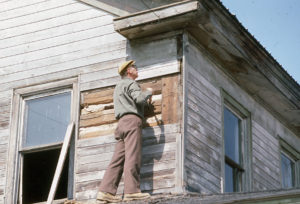 A farmhouse on the property south of Mount Union, purchased by Huntingdon County Business & Industry for an industrial park, proved to be a good-sized corner-post log house. The logs were of very modest dimensions; the building included medial posts front and back, and both sides. It was disassembled in 1990 and has been reconstructed in Colorado.
A farmhouse on the property south of Mount Union, purchased by Huntingdon County Business & Industry for an industrial park, proved to be a good-sized corner-post log house. The logs were of very modest dimensions; the building included medial posts front and back, and both sides. It was disassembled in 1990 and has been reconstructed in Colorado.
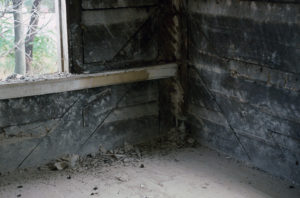
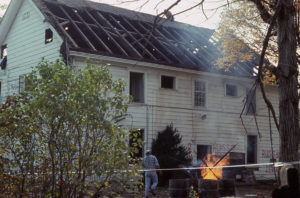
One of the most substantial corner-post structures I have seen was dismantled near Altoona in 1990 (shown above: back of the house on the left; diagonal corner bracing on the right). It measured 60’ x 40’ and included very wide wall planks and equally large diagonal bracing. The timbers were sawn, as in the Neff House in Huntingdon County. The house had two stone chimney stacks at each end. These and other elements of the construction, including 12-over-12 windows on the first story and 8-over-12 on the second, suggest a date no later than the 1820’s and perhaps much earlier.
